News
Possibility of New Working Styles through Collaboration between Humans and AI Updated in November 2020
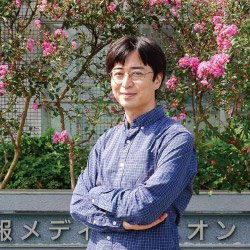
Professor
Library, Information and Media Science
University of Tsukuba
CREST Research Director
since 2016
Professor Morishima Atsuyuki at the University of Tsukuba (Library, Information and Media Science) is working to bring about “Cyborg Crowd,” in which people and AI work together to carry out a project. By breaking down work into small micro-tasks that can be easily processed, and by sharing them with AI and a large number of people, his team is trying to reduce time and ability constraints and to seek possibilities for new work styles. The goal is a society where everyone can use AI as a labor force and a society where people can choose from a wide range of work environments.
Enhancing Crowd-Sourcing
Simplify Work-Sharing by Dividing Work into Micro-tasks
The development of information technology has created a new form of employment called crowdsourcing. It literally means to outsource a certain workload to a dispersed crowd of people. A task is presented to an unspecified number of people online, and individuals or groups with requisite skills and knowledge to match the task provide the labor. Hiring costs used to be a significant expenditure to companies, but that is no longer necessary with crowdsourcing.
When an order is placed at Uber Eats─a food delivery service─the location of the store and the delivery address are displayed online. Someone who can respond at that specific moment undertakes the delivery. Eating and drinking establishments can provide home delivery services without hiring their own delivery staff, and the delivery people can work whenever and wherever they want.
Crowdsourcing is spreading rapidly and is expected to become even more popular in the future. Prof. Morishima Atsuyuki (Library, Information and Media Science, University of Tsukuba) is trying to enhance conventional crowdsourcing to include AI by creating a user-friendly mechanism called “Cyborg Crowd”. “In the future, it is expected that AI will work through the crowdsourcing model, but AI is still not an easily available technology. Therefore, we are trying to create an environment where anyone can easily recruit AI labor, and to enable everyone to work regardless of their situation or challenges.”
Even now, it is possible to request development of AI through crowdsourcing. However, it is difficult for non-experts to determine where and how to fix an AI system when it does not work. Not everyone would be able to use the systems as intended. Thus, instead of developing a single AI system, the idea is to regard multiple AIs as "crowd workers" and to allocate work to them. This is like crowdsourcing, which asks an unspecified number of people to do certain tasks even though it is unclear if the workers can be trusted or what their actual abilities are. To counter these potential problems, it is useful to have both technology that selects suitable people and technology that requests multiple people to integrate results if a single worker’s quality can’t be ascertained. These two technologies can expand to select and combine necessary AI to complete the outsourced task in an optimal way.
Cyborg Crowd breaks down work into smaller tasks called micro-tasks and allocates these micro-tasks to both humans and AI at the same time (Fig. 1). It is difficult to create an AI system that can handle an entire project from beginning to end. A system that encompasses AI that excels in certain parts of a task may already exist; utilizing such a system would increase productivity, and humans can undertake the tasks that cannot be handled by AI. Since micro-tasks can be completed in a very short time, people working under the conventional system will have far fewer tasks taking up their time. By dividing and allocating tasks, both workers and AI can flourish.
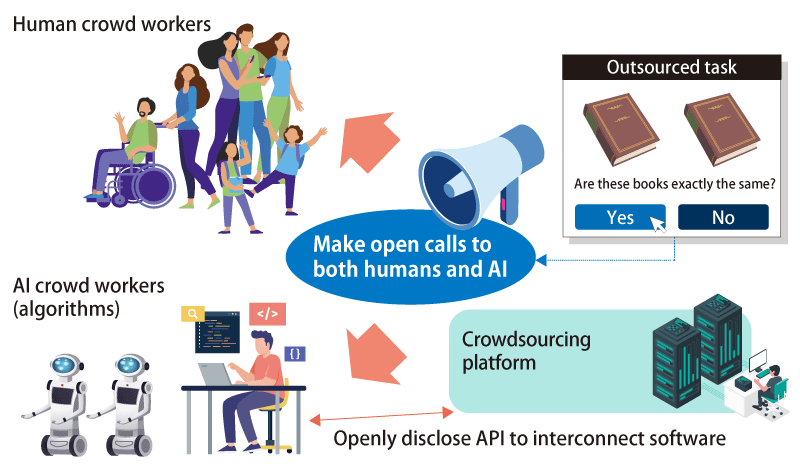
Quickly Grasping Disaster Situations
An International Disaster Prevention Drill with AI
One of the applications that Prof. Morishima's group envisioned from the beginning is disaster response. It is very difficult to build and operate a new system at a confusing disaster site. However, if necessary, measures to control the damage are broken down into micro-tasks and shared by the existing mechanisms and people in undamaged areas, countermeasures could be provided more quickly. The “International Cyber Disaster Response Drill” of October 2019 demonstrated this idea. In addition to Dr. Morishima and other CREST research teams, local governments that experienced large-scale disasters in the past participated, including Ehime Prefecture of Japan, Banda Aceh City of Indonesia (north of Sumatra island), and Syiah Kuala University in Banda Aceh.
Assuming that inundation or flood damage had occurred, the drill aimed to promptly grasp the situation and provide information for local governments to take countermeasures (Fig. 2). Satellite aerial photographs of the disaster area were broken down into smaller grids, and respondents were asked to judge whether each photograph looked flooded (Fig. 3). By sharing a large number of simple tasks, it is possible to determine whether a huge number of photographs show flooding or not. Reintegrating the photos makes it possible to quickly identify which parts of the wider area were actually flooded.
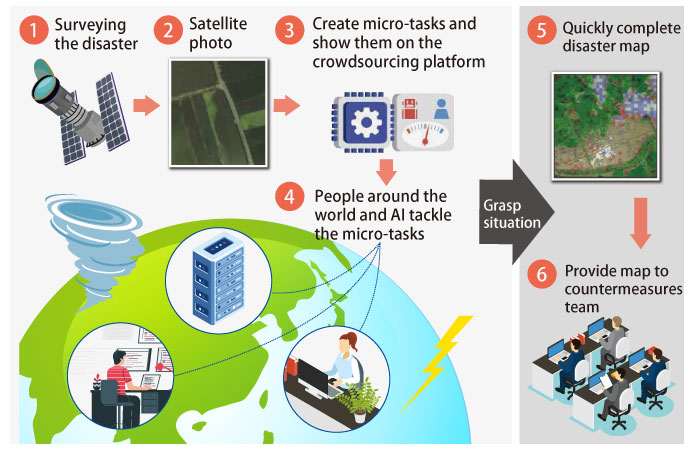
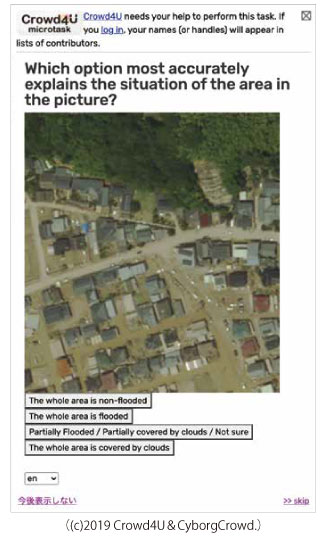
For this drill, Dr. Morishima collaborated with many people on the crowdsourcing platform Crowd4U. Approximately 600 people from 11 countries participated in the task. Participants included volunteers registered under Crowd4U. “AI developed by crowd workers also participated as an independent crowd worker. The AI learned from people’s decisions and estimated the overall picture of the damage. With the cooperation from many people and AI, a detailed disaster map was completed in four hours,” he proudly explained (Fig. 4).
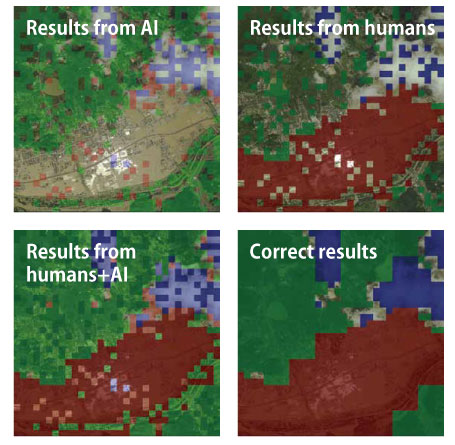
In the post-drill analysis, there were cases where AI correctly identified photographs that humans misidentified. Work efficiency and quality can be improved by allocating tasks between AI and people according to expertise. “Unlike developing an AI system independently after a problem occurs, a crowdsourcing task can materialize about an hour after obtaining a satellite photo. Furthermore, with Cyborg Crowd, crowd worker labor can automatically be shifted to AI ‘workers’, so it is really suitable for disaster countermeasures that require instant response.”
Achieve by Collecting Small Labor Forces
Increased Work Opportunities for Everyone
Dr. Morishima's other goal for Cyborg Crowd is to create a place where everyone can work, particularly people who have had difficulty working in the conventional employment system. “People with hearing disabilities for example, can participate in online photo analysis. If you can do the work from home in just a short time, people who aren’t able to work full-time due to family circumstances would be able to work. By breaking the workload down into micro-tasks, I think it will open up new avenues for those who don’t have a job or can’t work outside their home.”
Dr. Morishima’s team is also trying to develop the concept where a large number of people will gradually provide labor to solve problems without having to “work” in the traditional sense at all. One such attempt is to grasp the current state of ancient ruins using tourists. The Angkor archaeological site in Cambodia, registered as a World Heritage Site, has been exposed to wind and rain for many years and has deteriorated. Restoration projects are being carried out with Japan’s cooperation. Efficient restoration requires an accurate understanding of the ruins’ state, but it would be too costly to send experts to investigate on a regular basis.
The research group took note of the many tourists visiting Cambodia. If travelers provided their photos of the ruins, the team could superimpose and reconstruct the images to understand the extent of damage. However, tourists are not taking pictures for the purpose of research, so the shooting time and conditions differ. “It's not easy to find the same spot in a photo taken at different times and to track how the spot changed over time. A team of computer vision specialists helped out to locate the same spots within various photos taken at different times, and superimposed damaged spots from across many photos. Now it is possible to grasp even a slight change of 4 millimeters caused by the deterioration of the ruins, "says Dr. Morishima (Fig. 5).
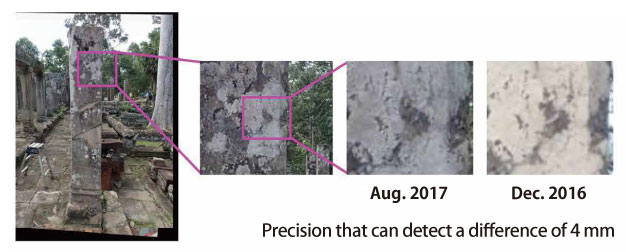
Furthermore, the team is also considering a mechanism that allows people to take part in “offline” tasks, to create more work opportunities. This attempt is named “Task on the Floor” where a task is displayed on the floor of a university hallway (Fig. 6). “Crowdsourcing in day-to-day living spaces, like placing a tablet and presenting tasks there, has been tried out before, but even if a passerby tries it once, it is difficult to get consistent cooperation out of them. In that respect, I thought that if a task was presented on the floor right in front of a person walking down a hallway, more people would take interest.” The team has so far experimented at four locations in three universities and many people did participate.
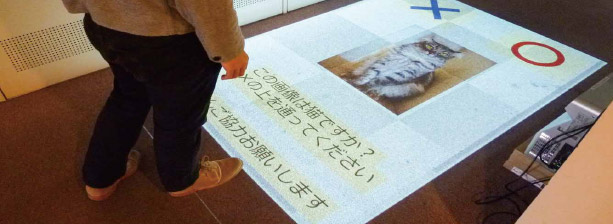
From these attempts, it seems like new ways to work could soon take form through the utilization of micro-tasks undertaken by both human crowds and AI. Still, there are issues that need to be considered: first among them, how to protect workers’ rights. Crowdsourcing is often criticized for paying low wages in exchange for labor. Exploitative structures do not provide sustainable working environments.
“I want to create a system that allows employers and workers to work as equals by valuing workers’ perspectives. We need to discuss what kind of design is fair to fulfill ELSI (ethical, legal, and social implications). Our working styles have changed significantly due to Covid-19. I think that it will be an opportunity to think about new ways of working that can make use of Cyborg Crowd,” reflected Dr. Morishima. At a training-camp style international conference in 2019, he opened discussions among researchers to explore better ways forward for machines and people, such as crowdsourcing, human-AI collaboration, and ELSI.
"The fun part of Cyborg Crowd is to complete a big project speedily by having humans and AI cooperate on micro-tasks.” says Dr. Morishima. The origin for his ideas goes back to his youth. “When I was a student, I belonged to a cheerleading team and a brass band. Maybe I'm doing this research because I want to relive the joy and excitement of accomplishing something together with my teammates,” he muses with enthusiasm. “When a problem arises, it would be great if we can solve it by bringing together AI and the knowledge of people from around the world. We’re aiming to contribute to the world by nurturing such a system.”
Original article on JST News October 2020
Translated by the SSC Secretariat







